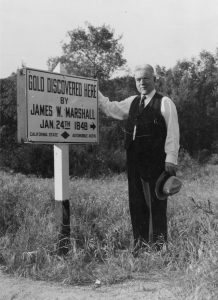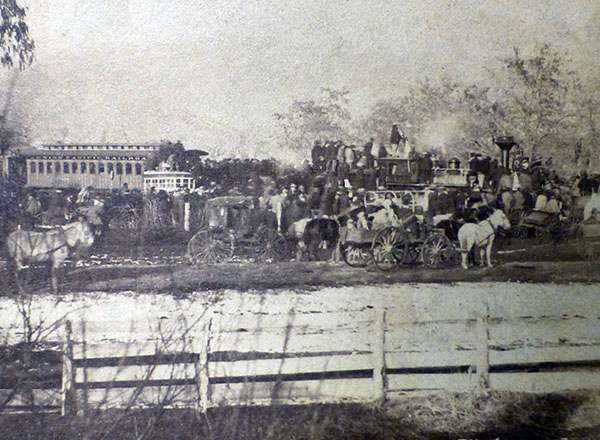Salt Lake West Side Stories: Post Eight
by Brad Westwood
Utah was never entirely isolated from the United States, Latin America, and the Pacific World. From the 1800s onward, the Great Basin was a point of intersection where people from many cultures interacted with one another in several ways.
One of the most well-known events that drew people west of the 98th meridian was the California Gold Rush. In January 1848, James W. Marshall discovered gold in Sutter Creek while working as a laborer at John Sutter’s Sawmill located near Coloma, California. News about the discovery spread quickly and inspired gold seekers to rush westward. Many of these overland travelers stopped in Salt Lake City to replenish their provisions. Others stopped in Salt Lake City simply because they wanted to visit a settlement that looked roughly like their eastern hometowns before continuing their travels westward. In all, the Salt Lake Valley became a popular stopover for the West’s overland travelers.

The Utah territory consisted of rough terrain for people moving from East to West. It took a wagon train, hand cart, or pedestrian travelers just under two months to reach Salt Lake City’s semi-desert location. Of course, the journey to Salt Lake City was not the driest, nor the hardest miles they would travel on their way to California. Just to the west of Salt Lake City lay the desert lands of the Great Basin (western Utah and Nevada), and then beyond this the Sierra Nevada Mountain Range, making Salt Lake City a prime location to water, feed, and rest livestock, while also stocking-up on provisions before continuing their journey. Those who grazed their livestock in meadows along the Jordan River, often infuriated the Mormon (members of The Church of Jesus Christ of Latter-day Saints) settlers who claimed the grassy lowlands as their grazing lands. Salt Lake City offered travelers a variety of suppliers and a restful Euro-American experience, before they moved westward to the U.S. territories of Oregon or California.
“Others stopped in Salt Lake simply because they wanted to visit a settlement that looked roughly like their eastern hometowns before continuing their travels westward.“
Gold seekers and immigrants were not the only people to visit Salt Lake City during the mid-1800s. Many famous Americans traveled to the Salt Lake Valley on stagecoaches, whose companies offered direct travel to California in 1859. Some of the most notable visitors included Horace Greely, Sir Richard F. Burton, and Mark Twain. Twain wrote about his 1860s observations of the “Great Salt Lake City,” in his travel book Roughing It (1872).

The railroad arrived in the Utah Territory twenty years after the California Gold Rush. On May 10, 1869, the United States celebrated the completion of the transcontinental railroad at Promontory Point, located just north of the Great Salt Lake. Seven months later, the Mormon-built Utah Central Railroad connected Salt Lake City to the transcontinental road. The ceremony for Utah Central’s “last spike” and the Utah Central Depot shared the same location at 400 West in between North and South Temple. The top photograph in this post is of The Church of Jesus Christ of Latter-day Saints’ (hereafter LDS Church) “last spike” ceremony. The site of the Utah Central Railway’s depot was intentionally constructed directly four blocks west of Temple Square, Brigham Young’s (second president of the LDS Church) property and the LDS Church’s headquarters. The arrival of the Utah Central Railroad was just the beginning of Utah’s ever-expanding network of railroads. The railroads further opened the West to Euro-American settlement. In Utah, many immigrants from around the world traveled on trains to join the Mormon migration movement or to work in the city’s new and thriving industries.
Join us for our next installment of Salt Lake West Side Stories where we will discuss the rapid changes the railroad brought to the west side and to Salt Lake City.
Do you want to read the next post (Post 9)? UTAH’S EXPANDING RAILROADS AND SALT LAKE’S WEST SIDE
Click here to return to the complete list of posts.
Related Activities: Visit Utah’s official state railroad museum the Museum at Union Station located at 2501 Wall Avenue on the west end of Ogden’s Historic 25th Street.
You may also want to learn about the broader story about Utah, railroads, and the West by consulting the Utah History Day teacher’s packet Our Past, Their Present: Teaching Utah with Primary Sources, entitled “Engines of Change: Railroads in Utah.”
Contributors: A special thanks to historians Will Bagley and Cassandra Clark for assisting with the contents of this post.
This post was researched and written by Brad Westwood with a whole lot of help from friends. Thanks to our sound engineer and recording engineer Jason T. Powers, and to his supervisor Lisa Nelson, both at the Utah State Library’s Reading for the Blind program. Thanks also to yours truly, David Toranto, for narrating this post.
Selected Works:
Michael Homer, On the Way to Somewhere Else: European Sojourners in the Mormon West, 1834–1930, (University of Oklahoma Press, reprint edition, 2017).
Ira Swett, “Interurbans of Utah” ed. Don Strack, from “Salt Lake & Utah Railroad” UtahRails.net, accessed April 18, 2023, Swett’s Salt Lake & Utah Railroad (utahrails.net).
Don Strack, “Salt Lake & Utah Railroad,” UtahRails.net, May 31, 2022, Salt Lake & Utah Railroad (utahrails.net).
Do you have a question or comment? Write us at “ask a historian” – askahistorian@utah.gov

